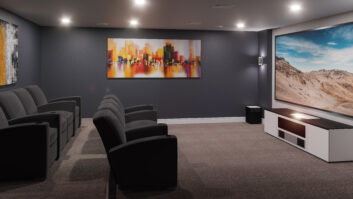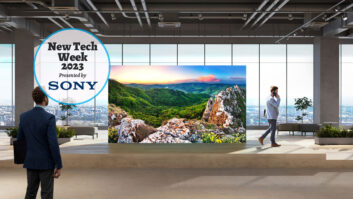It’s happened often: when people find out I write about the home technology industry, they ask my advice on home audio solutions. More times than not, their question is about the viability of a certain do-it-yourself brand (you know, the one that starts with an “S”). I say, “Sure, those systems are good. But do you want good, or great?”

Klipsch draws on its 70-year history of loudspeaker design to harness the dynamics and detail of a well-designed horn-loaded speaker in an in-wall format, such as its THX Certified Professional 7000 and 6000 series speakers. I go on to explain to these friends and acquaintances–especially those who I know have money to spend–that if they want a sound system that they’ll really love and want to show off, they need to hire an integrator to come install it. Because, as good as wireless audio technologies have become over recent years, they still can’t compete with the quality of a hardwired solution with in-wall and/or in-ceiling speakers.
“In-wall speakers remain a viable category because of the profitability, convenience, and, most importantly, performance that they offer over today’s Bluetooth speakers,” said Michael Buratto, product manager, component audio at Klipsch. “While Bluetooth speakers may offer a level of room-to-room portability to the end user, by no means can they match a truly integrated, customized distributed audio system.”
Brands like Klipsch also have the added advantage of experience–in this case, 70 years’ worth–in engineering top-notch solutions. “By developing the first horn-loaded in-wall speakers, we’ve been able to harness the dynamics and detail of a well-designed horn-loaded speaker in an in-wall format,” Buratto continued. “The best example of this would be our THX Certified Professional 7000 and 6000 Series–a true high-performance home theater system in an architectural form factor that could go toe-to-toe with any box speaker on the market for output, detail, and power.”

Paradigm’s CI Pro line of in-wall speakers is made in Canada and features patented developments such as Active Ridge Technology and Perforated Phase Alignment to heighten performance and extend reliability. In addition to the quality of the sound, consistency of coverage is also a key benefit of architectural loudspeakers. KEF, another iconic loudspeaker brand, has developed technologies for its in-wall speakers designed to ensure even coverage of sound throughout a space. “KEF brings its hallmark technology, the Uni-Q driver array, to many of our in-wall offerings,” said David Kroll, vice president of sales, U.S. “The Uni-Q offers extremely wide off-axis response with no shift in tonal balance, making it easier to place the speaker in any room. KEF has a wide range of offerings, from an array of traditional speakers to custom installation speakers, all of which are timbre matched.”
Beyond performance, aesthetics are also an increasingly important concern among consumers in choosing technology–especially in projects involving interior designers. Here, architectural audio wins again. “Wired in-wall speakers visually disappear in the room,” said Jim Garrett, director of marketing and product management for Harman. “Interior designers don’t particularly like big boxes of audio gear in the room, even if they are wireless. Our products use our Zero-Bezel grilles, which reduce the visual intrusion into the room.”

The Small Aperture model of in-ceiling speakers from James Loudspeaker is designed to deliver balanced, detailed sound through an opening just 3 inches in diameter. According to Garrett, Harman’s Revel and JBL brands have been working to incorporate the same technologies found in their traditional box loudspeakers–using the same materials, timbre matching, and double-blind listening tests–to create a product that sounds fantastic and blends in with a room’s décor. “For JBL Synthesis, it is our revolutionary SCL range of products–the first truly high-performance in-wall loudspeakers using professional-grade compression drivers mated to our patented High-Definition Imaging (HDI) waveguides,” he said. “These provide unprecedented dynamics and output capability with remarkably even coverage across a wide area.”
For Origin Acoustics, a brand primarily dedicated to the architectural loudspeaker category, the goal is to deliver audio quality that emulates the performance of a concert or movie theater, while aiming to keep the source of the sound out of sight, according to Taylor Nichols, director of marketing. “The biggest thing we are continuing to do is minimize the openings and aesthetics necessary for our speakers to operate without sacrificing performance,” he said. “Our revolutionary tool-less installation systems, Spring– Lock in the Composer (in-wall) and Zip-Clip in the Director (in-ceiling) collections–have opened up a new avenue of superior performance. We can fit larger woofer cones with higher efficiency and boosted SPL without increasing the visual footprint of our competitors.”

JBL Synthesis SCL in-wall speakers use professional-grade compression drivers with patented High-Definition Imaging (HDI) waveguides for high dynamics and even coverage. This includes bass performance as well: the company’s Director in-ceiling subwoofers are engineered to deliver “powerfully deep bass” through magnetic, bezel-less grilles that match the openings for 6-and 8-inch speakers.
Some manufacturers, such as custom-solution specialist James Loudspeaker, look at hardwired, architectural solutions as a completely different kind of system than wireless multi-room audio. “Wireless audio solutions for the most part address a different market segment than premium whole-house entertainment products,” said Ted Telesky, James’ chief marketing officer. “Our product offerings span multiple categories, such as home theater, landscape (outdoor) audio, distributed audio, and marine applications. Almost all of our products are engineered and manufactured in the USA specifically to address the needs of custom integration professionals.”
Like Origin, James has devoted significant engineering to developing versatile solutions that have a minimal influence on a space’s aesthetics. “James Loudspeaker just introduced a new Small Aperture model called the 63SA-7HO,” Telesky continued. “This new architectural speaker is ideal for in-ceiling applications and has been engineered to deliver high output and rich, deep bass, making it well suited as a surround speaker for home cinema as well as whole-house audio, where higher output levels are desired. Amazingly, all of this balanced, detailed sound comes out of an extraordinarily small 3-inch opening that can be fitted with a barely noticeable square or round grille.”

SpeakerCraft’s AIM 2 ATX100 in-wall units use upward-firing speakers to generate ceiling reflections for Dolby Atmos objectbased audio. The utilization of architectural speakers as part of a home theater system has been one area driving the growth of the category as of late, thanks to one particularly important development: immersive 3D audio technologies. SpeakerCraft is one brand that has been working to capitalize on this boom. “We see many possibilities related to object-oriented surround audio, such as Dolby Atmos and DTS:X,” said Matt Dever, Core Brands product manager, Audio. “This fall, SpeakerCraft is launching the first Dolby Atmosenabled in-wall height speaker, the SpeakerCraft AIM Series 2 ATX100. Like the floor-standing add-on modules currently available supporting Dolby Atmos for the home, this new in-wall speaker reflects the height “object” information off of the ceiling. The result is amazing; the demonstrations that we’ve done at recent trade and dealer shows have blown people away with a truly immersive experience.”
According to Dever, the company will concurrently introduce an AIM 2 version of its in-wall LCR speakers, featuring the same tweeter array design of the ceiling-mounted counterparts. “Together with the height speaker, these create stunning Dolby Atmos-enabled in-wall speaker systems that can support the wide array of Dolby Atmos-enabled configurations,” he said.

Origin Acoustics Director in-ceiling subwoofers are engineered to deliver “powerfully deep bass” through magnetic, bezel-less grilles that match the openings for 6- and 8-inch speakers. Besides the quality, aesthetic, and versatility advantages of a hardwired system, there’s one more attribute that wireless systems can’t quite match: reliability. “Wireless networks and streaming solutions have made major improvements in the last few years, but when a customer wants a system to work right 100 percent of the time with the least amount of headache, a wired system connection is preferable,” said Devin Zell, marketing manager at Paradigm. “Many custom integrators, when deploying wireless-capable streaming solutions, still choose to connect those wireless devices using a hardwired ethernet connection to provide their customers with the most reliable streaming experience possible.”
To help ensure the reliability of its CI Pro and CI Elite custom installation solutions, Paradigm carries out all of its manufacturing in its home country of Canada. These solutions feature patented developments–such as Active Ridge Technology–to heighten performance and reduce output distortion. “Our cones and surrounds are over-molded to extend product reliability and PPA (Perforated Phase Alignment) technology improves the dispersion characteristics of our speakers,” Zell said. “These are only a few of the many technologies we bring to play in our custom install products.”
So, while there might not be nearly as much awareness of the merits of architectural speakers among the general public, there’s certainly a whole lot of exciting new developments going on behind the drywall.
Matt Pruznick is associate editor of Residential Systems and Systems Contractor News. Follow him on Twitter @Pruznick.







